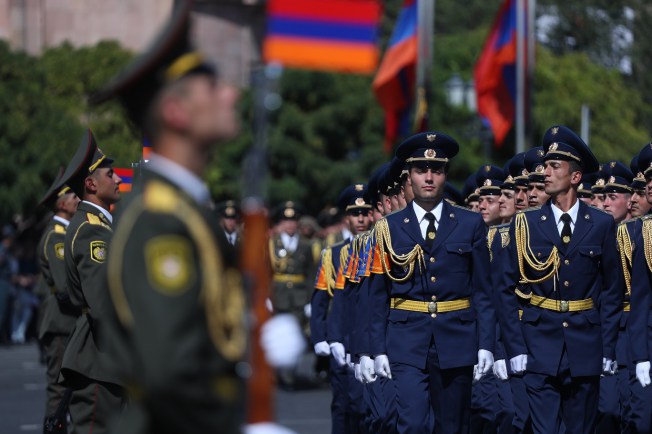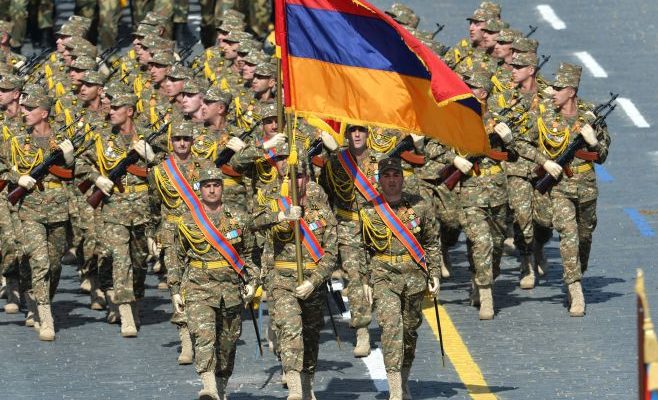At the Armenian diaspora’s Sixth Pan-Armenian Forum, held on September 18–20, Armenian Foreign Minister Eduard Nalbandian declared that Yerevan was discussing the possible handover of some occupied territories back to Azerbaijan, in line with formerly accepted principles agreed upon by both sides in negotiations over Karabakh (Rusrminfo, September 18). Addressing the questions pertaining to Armenia’s commitment to reaching a peaceful solution, Nalbandian made clear that the territories in question “constitute no threat to the security of Artsakh [formerly self-identified as the ‘Nagorno-Karabakh Republic’ ” (Azatutyun, September 18).

The minister’s revelations sparked growing irritation within Armenian society, although the issue of territorial concessions is nothing new and is firmly enshrined in the Madrid Principles, which Armenia and Azerbaijan agreed to in order to help resolve the Karabakh crisis. Seeking to assuage the mounting domestic resentment, Deputy Foreign Minister Shavarsh Kocharyan provided additional explanations, asserting “nobody [was surrendering] any territory” and that the backlash was a deliberate misinterpretation of Nalbandian’s remarks (Panorama, September 19). Instead, Kocharyan pointed to Armenia’s toughened posture since the major escalation along the “line of contact” (LoC) in Karabakh, back in April 2016. He insisted no progress in negotiations would be possible without the creation of an incident investigation mechanism as an integral part of confidence-building measures, unanimously agreed upon at the Organization for Security and Cooperation in Europe’s (OSCE) Minsk Group May 2016 Vienna summit (1in.am, September 20).
However, last September’s joint statement released by the OSCE Minsk Group co-chairs actually failed to refer to the Vienna summit document (Osce.org, September 23). This omission, combined with Baku’s reluctance to unequivocally endorse the Vienna document, has led to the view in Armenia that the Vienna agreements may ultimately prove irrelevant and thus unfeasible to implement. This nuance appeared all over the Armenian press and contributed negatively to Nalbandian’s revelations.
In addition, the Armenian foreign minister’s statement coincided with Azerbaijani demonstrations of new arms procurements, which include Czech-manufactured artillery equipment, such as the DANA-M1 self-propelled 152-millimeter howitzers and RM-70 Vampir multiple-launch rocket systems (MLRS) (Haqqin.az, September 18). Against this background, in conjunction with Azerbaijan’s ongoing military drills to hone its large-scale offensive capabilities, Nalbandian’s remarks were judged by many in Yerevan as, at the very least, inadequate. Indeed, the unprecedented fighting that erupted in April 2016 resulted in roughly 350 deaths and left Armenian society more sensitive and uncompromising in terms of future territorial concessions.
Hence, Armenia’s chief of the General Staff, Lieutenant General Movses Hakobian, sought to defuse the unease within society triggered by the foreign minister’s comments at the Pan-Armenian conference. Touching upon this issue, Hakobian stressed that even insignificant territorial alterations to the “security belt [i.e. the occupied Azerbaijani provinces]” surrounding Karabakh might cause dramatic consequences for Artsakh’s security. He said he could not imagine any kind of territorial handover by Armenia that would not jeopardize Artsakh’s security, concluding, “we need new and better territories to ensure the security [of Artsakh]” (Armenpress, September 21).
This viewpoint seems to be increasingly prevalent in the Armenian military’s strategic mentality, suggesting that the Armenian side is prepared to expand the so-called “security belt” even deeper into Azerbaijan’s territory, if the latter attempts to resolve the Karabakh dispute by military means. In this context, since 2015, Armenia is striving to adopt a concept of pre-emptive deterrence and modern warfare tactics (Azatutyun, February 18, 2016).
Officially unveiled, in February 2016, by former deputy defense minister David Tonoyan, Armenia’s so-called “Deterrence System” concept aims to decrease the intensifying incidents across the LoC in Karabakh (Mil.am, February 18, 2016). It seeks to undermine Azerbaijan’s escalation dominance. The concept supersedes the Armenian military’s obsolete Soviet-style “Static Defense” doctrine, and it opens the door to an Armenian pre-emptive strike in case an assault by the adversary is deemed to be “imminent” (Rosbalt, January 26, 2015).
From Azerbaijan’s perspective, the full-range implementation of Armenia’s deterrence concept is a potential game changer and might result in a fundamental revision of Baku’s escalation dominance strategy, which heretofore has mainly favored Azerbaijan. This development likely motivated the Azerbaijani leadership to undertake its “controlled” four-day intensive fighting in April of last year in order to nullify Yerevan’s potential leverage stemming from pre-emptive deterrence. Although, as the author was advised by the Armenian defense ministry, an “active deterrence” concept is already in place and is undergoing additional elaboration. Therefore, at least theoretically, it could be applied if the Azerbaijani side pursues “controlled escalation” operations.
Meanwhile, Baku’s military-strategic planning is not difficult to discern: by leaving open the potential for an attempted military solution to the Karabakh problem, Azerbaijan has no option but to try to negate the effectiveness of Armenia’s counter-offensive capabilities. Most importantly, a top concern for Baku is the security of its hydrocarbon infrastructure—currently exposed to Armenian ballistic missiles. To this end, Azerbaijan has reportedly embarked on deploying the Israeli-made Iron Dome air-defense and anti-missile system in Baku and Ganja in order to boost the security of the southeastern Caucasus country’s strategic transportation and other communications infrastructure (Apsny.ge, September 21).
And while Azerbaijan had announced military budget cuts for 2017, Armenia is boosting its defense expenditure by up to 17 percent for 2018 (PanArmenian, September 28). Even in the long run, Armenia will not be in a position to overtake Azerbaijani prowess in defense-related spending. Nonetheless, according to Defense Minister Vigen Sargsyan, these funds, coupled with other extra-budgetary sources, will be devoted to new arms acquisitions (Razm.info, October 2).
Finally, the Armenian rhetoric about using the Iskander-E ballistic missile systems to target Azerbaijan’s hydrocarbon infrastructure if the latter launches a full-scale war serves mainly as a political tool of containment and is hyped heavily for domestic consumption. In reality, it is unlikely that the Armenian side would risk damaging the Azerbaijani portion of a transregional energy network that is of increasing importance for Europe’s energy security, particularly amidst the lingering Russian-Western rift. Rather, “the defense army of Artsakh” might be tasked with taking effective control over some segment of Azerbaijan’s energy infrastructure located in the strategic vicinity of the Karabakh LoC, but commanded to avoid any disruption to the functionality of those pipelines. This shift in strategic thought also fits Armenia’s evolving “active deterrence” concept.
The article was originally published on www.jamestown.org 11/10/2017
Eduard Abrahamyan is a regional and global security policy analyst focusing on the Black Sea, Caucasus and Central Asia. He is a Doctoral Research Fellow at the University of Leicester, UK. Abrahamyan is a CEO of Armenia-based Council for Co-operation with NATO. He is also a regular contributor to the IHS Market (Jane’s), Central Asia-Caucasus Institute at American Foreign Policy Council and to The Jamestown Foundation.







